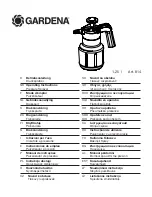
2
Operating Instructions and Replacement Parts List
Description
Airless paint sprayers are capable of
spraying a wide variety of latex, oil-
based, and alkyd paints, as well as
stains, preservatives and other non-
abrasive finishes. Sprayers are also pow-
erful and versatile enough to be used
with a variety of options (roller attach-
ment, extra lengths of hose, etc.) to be
an even more efficient tool.
Important Safety Instructions
Save these instructions.
This manual contains information that is
very important to know and understand.
This information is provided for SAFETY
and to PREVENT EQUIPMENT PROBLEMS.
To help recognize this information,
observe the following symbols.
Danger indicates
an imminently haz-
ardous situation which, if not avoided,
WILL result in death or serious injury.
Warning indicates
a potentially haz-
ardous situation which, if not avoided,
COULD result in death or serious injury.
Caution indicates a
potentially haz-
ardous situation which, if not avoided,
MAY result in minor or moderate injury.
Notice indicates
important informa-
tion, that if not followed, may cause
damage to equipment.
Unpacking
After unpacking the unit, inspect care-
fully for any damage that may have
occurred during transit. Make sure to
tighten fittings, bolts, etc., before
putting unit into service.
Do not operate
unit if damaged
during shipping, handling or use.
Damage may result in bursting and
cause injury or property damage.
General Safety Information
1. To reduce the risk of fire
or explosion, electrical
shock, and injury to per-
sons, read and understand
all instructions included
with this product. Be familiar with
the controls and the proper use of
the equipment.
2. This product should be grounded.
Follow all grounding instructions
included with your sprayer (pump).
!
WARNING
NOTICE
!
CAUTION
!
WARNING
!
DANGER
To reduce risk of fire or
explosion:
1. Do not spray flammable or com-
bustible materials near an open
flame or sources of ignition such as
cigarettes, motors, and electrical
equipment.
2. Paint or solvent flowing through
the equipment is able to result in
static electricity. Static electricity
creates a risk of fire or explosion in
the presence of paint or solvent
fumes. All parts of the spray system,
including the pump, hose assembly,
spray gun, and objects in and
around the spray area shall be prop-
erly grounded to protect against
static discharge and sparks. Use only
conductive or grounded high-pres-
sure airless paint sprayer hoses spec-
ified by the manufacturer.
3. Verify that all containers and collec-
tion systems are grounded to pre-
vent static discharge.
4. Connect your sprayer to a grounded
outlet and use grounded extension
cords. Do not use a 3 prong to 2
prong adapter.
5. Do not use paints or solvents con-
taining halogenated hydrocarbons
such as methyl bromine, carbon
tetrachloride, and ethyl iodine.
6. Keep spray area well ventilated.
Keep a good supply of fresh air
moving through the spray area.
7. Do not smoke or eat in the spray
area.
8. Do not operate light switches,
engines, or similar spark producing
products in the spray area.
9. Keep area clean and free of paint or
solvent containers, rags, and other
flammable materials.
10. Know the contents of the paints
and solvents being sprayed. Read all
Material Safety Data Sheets (MSDS)
and container labels provided with
the paints and solvents. Follow the
paint and solvent manufacturer’s
safety instructions.
11. Do not use materials with a flash
point less than 20°C (70°F) in or to
clean this equipment. (Examples of
acceptable cleaning solvents are:
water, mineral spirits, lacquer thin-
!
WARNING
ner, Xylene and high flash naphtha.
A PARTIAL example list of unaccept-
able cleaning solvents are low flash
naphtha, mek, acetone, alcohol,
toluene and fuels of any kind.
12. Have fire extinguisher equipment
present and working.
To reduce the risk of
skin injection:
1. Do not aim the gun at, or spray, any
person or animal.
2. Keep hands and other body parts
away from the discharge. For exam-
ple, do not try to stop leaks with
any part of the body.
3. Always use the nozzle tip guard. Do
not spray without nozzle tip guard
in place.
4. Do not remove tip while cleaning
the pump.
5. Only use a nozzle tip specified by
the manufacturer.
6. Use caution when cleaning and
changing nozzle tips. Before remov-
ing the nozzle tip, follow the manu-
facturer’s instructions for turning
off the unit and relieving the pres-
sure.
7. Do not leave the unit energized or
under pressure while unattended.
When not in use turn off the unit
and relieve the pressure in accor-
dance with the manufacturer’s
instructions.
8. High pressure spray is able to inject
toxins into the body and cause seri-
ous bodily injury. In the event that
injection occurs, seek medical atten-
tion immediately.
9. Check parts for signs of damage.
Replace any damaged parts.
10. This spray gun is rated for 3000 psi
(205 bar). Do not use on systems
designed to produce more than
3000 psi (205 bar).
11. Always engage the trigger lock
when not spraying. Verify the trig-
ger lock is functioning properly.
• To lock (engage): rotate tabs on
lock to horizontal position.
• To unlock (disengage) to spray:
rotate tabs on lock to vertical position.
!
WARNING
MANUAL
www.chpower.com


































